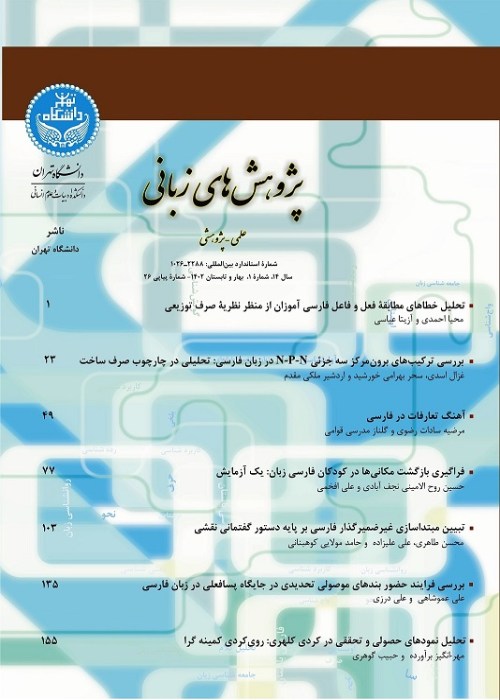Persian Prefixoids: A Cognitive Analysis
Author(s):
Article Type:
Research/Original Article (دارای رتبه معتبر)
Abstract:
Affixoid is a frequent word attached to different bases, plays the role of derivational affixes and makes derivational words. These linguistic elements are morphologically independent but by the passage of time and under the influence of different factors, they attain different figurative meanings and are present in derivational words. In this research, we study 2 Persian prefixoids,"khosh-, bad-" which have opposite meanings and have ahigh frequency in Persian, in cognitive morphology framework and based on Hamawand (2011). It is corpus-based and the corpus used is Sokhan Dictionary. Firstly all words containing these elements are listed and the classified and analyzed. These elements have all three cognitive operations; categorization, configuration and conceptualization. Based on categorization operation, these elements besides their denotational meanings, have other meanings some of which are prototypical and some are peripheral. Prefixoid “khosh-“has 2 prototypical meanings, beauty and goodness, and 5 peripheral meanings, abundance, faithfulness, lack, skill, ease, and prefixoid “bad-“ has 1 prototypical meaning, ugliness, and 5 peripheral meanings, abundance, unfaithfulness, hardship, severity, positive attitude. Based on configuration operation, different domains are studied. Each of these prefixoids has specific domains and separate facets. Prefixoid “khosh-“has 2 domains, quantity and manner, and “bad-“ has distinction domain. And finally based on conceptualization operation, we study words which have the same bases but synonymous prefixes are attached to them and different construals are attained such as “more than usual vs. excessive” by the use of prefixoids “khosh-“ and “por-“ attached to the base “Namak”, “quantity vs. quality” by the use of the previous mentioned prefixoids attached to the base “kar” and the last construal “humor vs. insult” which is made by the use of prefixoids “bi-“ and “khosh-“ by the base “Gheirat”. Based on the findings of this study, all linguistic elements have senses that represent speakers’ different mental experiences and prefixes, generally, and prefixoids, specifically, are not exceptional.
Keywords:
Language:
Persian
Published:
Language Research, Volume:10 Issue: 2, 2020
Pages:
83 to 105
magiran.com/p2115063
دانلود و مطالعه متن این مقاله با یکی از روشهای زیر امکان پذیر است:
اشتراک شخصی
با عضویت و پرداخت آنلاین حق اشتراک یکساله به مبلغ 1,390,000ريال میتوانید 70 عنوان مطلب دانلود کنید!
اشتراک سازمانی
به کتابخانه دانشگاه یا محل کار خود پیشنهاد کنید تا اشتراک سازمانی این پایگاه را برای دسترسی نامحدود همه کاربران به متن مطالب تهیه نمایند!
توجه!
- حق عضویت دریافتی صرف حمایت از نشریات عضو و نگهداری، تکمیل و توسعه مگیران میشود.
- پرداخت حق اشتراک و دانلود مقالات اجازه بازنشر آن در سایر رسانههای چاپی و دیجیتال را به کاربر نمیدهد.
In order to view content subscription is required
Personal subscription
Subscribe magiran.com for 70 € euros via PayPal and download 70 articles during a year.
Organization subscription
Please contact us to subscribe your university or library for unlimited access!



